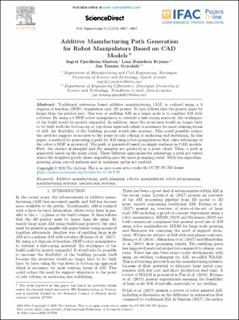| dc.contributor.author | Onstein, Ingrid Fjordheim | |
| dc.contributor.author | Evjemo, Linn Danielsen | |
| dc.contributor.author | Gravdahl, Jan Tommy | |
| dc.date.accessioned | 2021-09-03T11:43:30Z | |
| dc.date.available | 2021-09-03T11:43:30Z | |
| dc.date.created | 2021-01-18T12:25:48Z | |
| dc.date.issued | 2020 | |
| dc.identifier.issn | 2405-8963 | |
| dc.identifier.uri | https://hdl.handle.net/11250/2772866 | |
| dc.description.abstract | Traditional extrusion based additive manufacturing (AM) is realized using a 3 degrees of freedom (DOF), translation only, 3D printer. It then follows that the printer must be larger than the printed part. One way of enabling AM on a larger scale is to combine AM with robotics. By using a 6 DOF robot manipulator to extrude a fast-curing material, the workspace of the build would be greatly expanded. In addition, since the structures would no longer have to be built with the bottom-up or top-down approach which is necessary for most existing forms of AM, the flexibility of the building process would also increase. This could possibly reduce the need for support structures to the point of only relying of anchoring and stabilizing. In this paper, a method for generating a path for AM using robot manipulators that takes advantage of the robot’s DOF is presented. The path is generated based on simple surfaces in CAD models. First, the surface is sampled and the samples are gathered in a point cloud. Then, a path is generated based on the point cloud. Three different approaches for generating a path are tested where the weighted greedy choice algorithm gave the most promising result. With this algorithm, printing along curved surfaces and in nonlinear paths are enabled. | en_US |
| dc.language.iso | eng | en_US |
| dc.publisher | International Federation of Automatic Control (IFAC) | en_US |
| dc.rights | Attribution-NonCommercial-NoDerivatives 4.0 Internasjonal | * |
| dc.rights.uri | http://creativecommons.org/licenses/by-nc-nd/4.0/deed.no | * |
| dc.title | Additive Manufacturing Path Generation for Robot Manipulators Based on CAD Models | en_US |
| dc.type | Peer reviewed | en_US |
| dc.type | Journal article | en_US |
| dc.description.version | publishedVersion | en_US |
| dc.source.journal | IFAC-PapersOnLine | en_US |
| dc.identifier.doi | https://doi.org/10.1016/j.ifacol.2020.12.2724 | |
| dc.identifier.cristin | 1873150 | |
| dc.relation.project | Norges forskningsråd: 237900 | en_US |
| dc.description.localcode | © 2021, IFAC (International Federation of Automatic Control) Hosting by Elsevier Ltd. Under a Creative Commons CC-BY-NC-ND license (https://creativecommons.org/licenses/by-nc-nd/4.0/). | en_US |
| cristin.ispublished | false | |
| cristin.fulltext | postprint | |
| cristin.qualitycode | 1 | |

